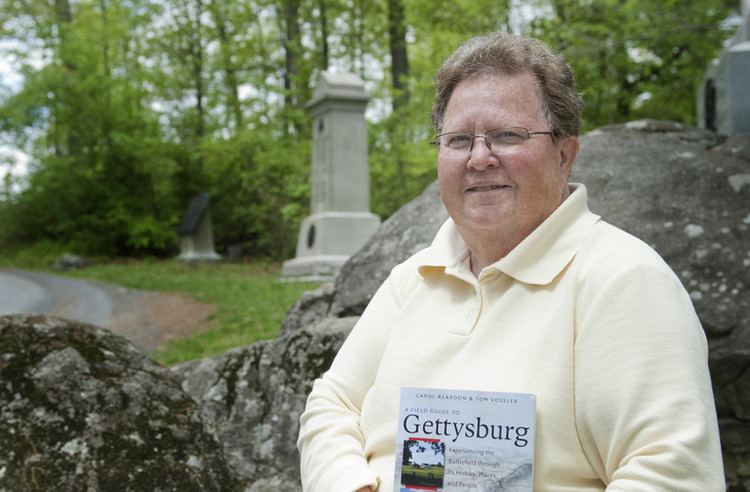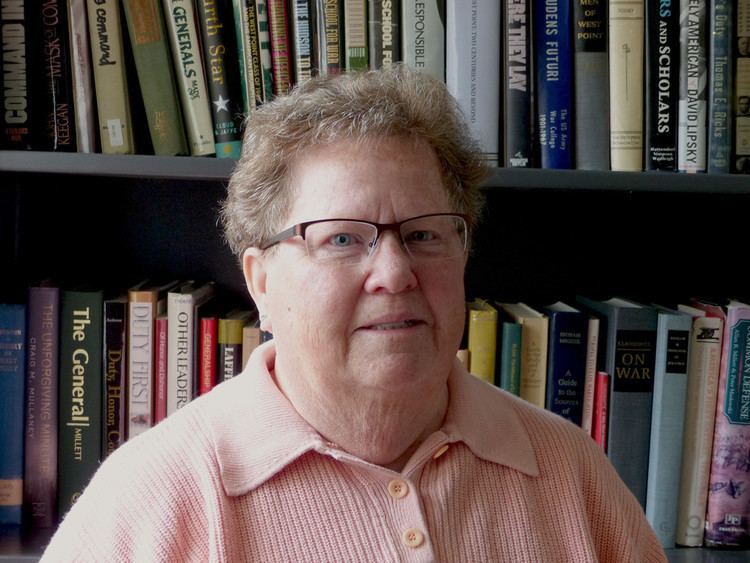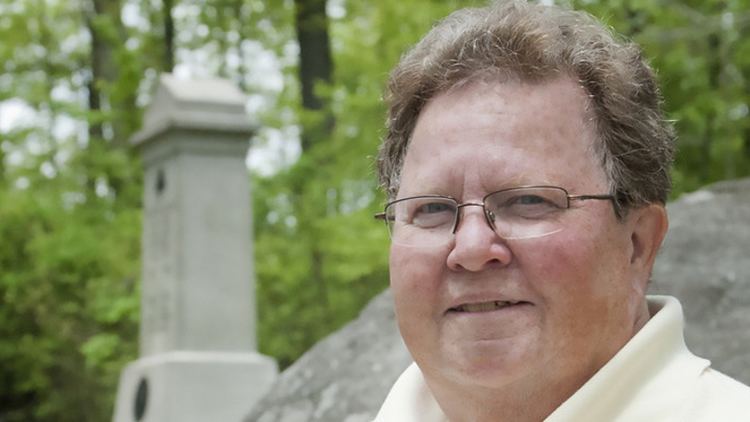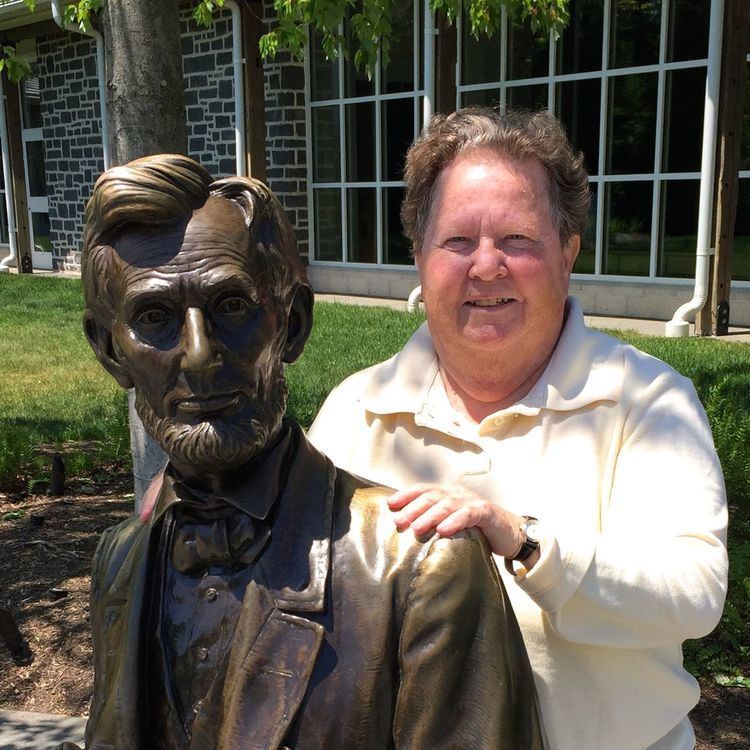Name Carol Reardon | Role Historian | |
 | ||
Main interests American military history Notable awards Helen Dortch Longstreet Prize, Victor Gondos Memorial Service Award, William Woods Hassler Award for Excellence in Civil War Education Books Pickett's charge in history an, Launch The Intruders, A Field Guide to Gettysbur, Soldiers and scholars, Pickett's Charge - July 3 an | ||
telling the army story voices of gettysburg s slain by dr carol reardon
Carol Reardon is an American military historian with a concentration in Civil War and Vietnam eras. She is a George Winfree Professor of American History at Pennsylvania State University.
Contents
- telling the army story voices of gettysburg s slain by dr carol reardon
- Carol reardon
- Academic life
- Publications
- An interview with Carol Reardon On Civil War history literature and popular memory
- C Span Open Phones with Carol Reardon
- C Span Picketts Charge Panel
- Awards
- References

Carol reardon
Academic life

Reardon received a Bachelor of Science from Allegheny College in 1974, a master's at University of South Carolina in 1980, and a doctorate at University of Kentucky in 1987. In addition to teaching at Penn State, Reardon is a visiting professor at United States Military Academy at West Point and has taught at the U.S. Army War College. Reardon has been a faculty member at Marine Corps Command and Staff College, U.S. Army War College, U.S. Army Military History Institute, and University of Georgia. Additionally, Reardon was the Associate Editor on The Papers of Henry Clay Documentary Editing Project. Reardon is a scholar-in-residence at the George and Ann Richards Civil War Era Center at Penn State University, and an associate professor.
Publications

An interview with Carol Reardon: On Civil War history, literature, and popular memory

Reardon state that she still believes that historians are interested in literary and nontraditional sources because these sources allow the reader to understand many different aspect of society. For instance, women and children's studies are able to be researched through nontraditional sources, such as schoolbooks, song, poetry, etc. Nontraditional sources are able to fill in the blanks between the home-front and the battlefield. She thinks they are both wartime literature and post-wartime literature are important. Wartime literature allows historians to determine what the understanding of the war was. Post-wartime literature is important because it allows historians to see how the understanding has changed. What was remembered, what was lost, and what was changed that may have no foundation in reality. The question that comes from comparing those sources is why they changed. Additionally, literature allows historians to know the underlining emotions that the author felt and sales enable historians to see if the public felt the same way. Literature demonstrates the political and social strains during that time period. Reardon believes that sources that combined nonfiction and fiction are good tools to develop a strong historical methodologies. Historians need to do the research in order to determine if author could have known the information at the time or it became knowledge after the fact. Reardon explains the difference between Civil War novel and the Civil War memoirs. With the novel, the author enters the project with no desire to keep within nonfiction; however, with memoirs authors begin with the intention to stay true, yet once history becomes either dark or boring they add fictional elements. Reardon uses the Battle of Gettysburg to demonstrate how popular memory of the Civil War changes. Now, the Battle of Gettysburg is seen as a unifying symbol and the end of the Civil War; however, that was not always how it was seen. After the Civil War, Gettysburg was primarily targeted to inspire pride in the Union Army and the North. Many Southerners did not make the journey to Gettysburg because there was not much incentive to attend. It was not until the late 1880s that the Battle of Gettysburg began to be expressed in dramatic unifying moment in United States' history. Finally, Reardon examines the novel The Killer Angels by Michael Shaara. Reardon argues that the novel is useful creates a different perspective of actors in the Civil War which allows people to being to study historiography. Additionally, a fictional novel can promote the public to begin to read non-fiction work on the Battle of Gettysburg. However, Reardon cautions that readers believe that the characters are real and if they are not, it can turn them off from reading.
C-Span: Open Phones with Carol Reardon

This appearance was to discuss the history of the Battle of Gettysburg on the 150th anniversary. She was asked how the celebrations have changed over the years. Reardon explains that the greatest amount of monument building that are on the Gettysburg field happened 1880s to 1900s. The monuments were often built by the Civil War Veterans who wanted to have a large say in the design of the monument. The 73rd New York monument is a soldier and a fireman because many of the soldiers were fireman and they wanted to show how the fireman could become the soldier. 42nd New York monument is a Native American teepee, it represents Tammany Hall which was the Democratic Political Machine in New York. Between regiments there were arguments over the land in order to place their monuments. Both the 2nd and 11th core wanted Cemetery Hill. The originally ruling by the Gettysburg Part authorities was that it should be the 11th core because they were the ones who were main line was actually on Cemetery Hill. However, the 2nd were necessary on the line at Cemetery Hill when the Confederate Soldiers broke through briefly on the night of the 2nd. Additionally, the 2nd did not have a main section anywhere else to build their monument. On another note, Confederate soldiers were not allowed to be buried at the National Cemetery and were buried wherever they left. And it was until the 1870s, that Southern women decided to raise the money to bring the bones back home. Reardon discusses paroled soldiers. Initially, when a soldier was paroled they had to promise to go home until they were notified that they had been exchanged. However, many soldiers continued to stay home after they received their notification, so they created parole camps. These camps held the paroled soldiers and leaders from both Union and Confederate parole camps would meet and agree on an exchange. If a soldier was officially exchanged then they would be told to go back to their regiment.
C-Span: Pickett's Charge Panel
This television appearance was a discussion panel including the following historians: Troy Hartman, Jeffry Wert, Richard Sommers, and Peter Carmichael. One topic that Reardon discussed is that Lee came to the conclusion to attack in a reasonable way. He evaluate all his options compared them to his ultimate objective. Reardon explains that the first thing that Lee witnessed of day one of Gettysburg is the final attack of the day. It was an attack on open ground and it was a smaller scale of what were later be used at Pickett's Charge. Additionally, on the second day a small amount the Confederate forces were able to get close to the Union line. Ultimately, Reardon argued that Lee asked himself the question 'What can I do?' and then devised a logical plan for the third day. One issue Reardon explains is that it is not concretely known what was Lee's intention at Gettysburg because there are not a lot of primary sources. For example, there were no notes taken at the meeting between Jefferson Davis and Lee; thus, it is not known was discussed there. At the time of the Civil War, it was not required that there be a commander's intent. Reardon does discuss that the purpose for artillery bombardment was to destroy the Union's artillery in order to hit an area target of both Clump of Trees and Ziegler's Grove. Reardon also discussed how historians believe that Lee was aiming for the seam between two different Union groups. At the end of the talk, Reardon explains how the Union army did a great job at Gettysburg.
Awards
Reardon has been awarded the Helen Dortch Longstreet Prize from the Longstreet Society (2009), Victor Gondos Memorial Service Award from the Society for Military History (2009), George W. Atherton Award for Excellence in Teaching from the Penn State University (2007), and William Woods Hassler Award for Excellence in Civil War Education from the Civil War Education Association (2004).
